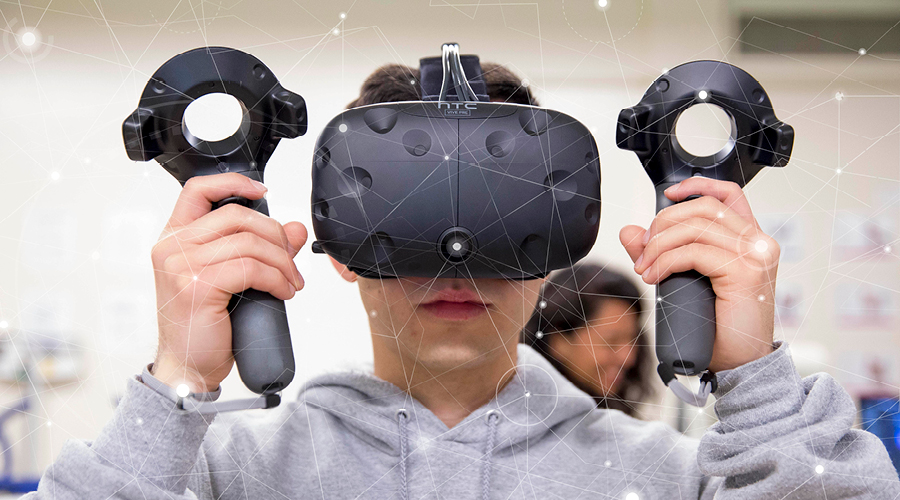A groundbreaking SF State study suggests VR could be the key to fitness for tomorrow’s gamers

By Matt Reed
Forget the old stereotype of video game-loving couch potatoes wasting away as they play the latest “Call of Duty” for days at a time. Gaming could be a key component in keeping future generations fit, SF State researchers believe.
In the first study of its kind in the U.S., the Department of Kinesiology has begun establishing itself as a pioneer in the research of augmented exercise, which uses virtual reality games as part of a regular workout routine to promote physical fitness. Since January, a team of researchers led by Professor Marialice Kern has been analyzing the metabolic energy expended while playing VR games.
“Nearly all virtual reality games involve some form of movement,” says Kern, the chair of the Department of Kinesiology. “Some are as simple as turning your head from left to right, but others require very vigorous movement, like dancing. What we wanted to know was: How much energy do people expend while playing VR games, and can it really be considered exercise?”
During the initial study, SF State graduate student Dulce Gomez led a team of undergraduate researchers collecting information on heart rate and oxygen consumption (which was then converted to energy expenditure data) from more than 40 subjects during the spring semester. Subjects performed activities such as boxing in a virtual ring (13-18 calories per minute) and played other games that included using a bow and arrow on an archery course or dodging colorful orbs to a musical beat (four to six calories/minute).
“You can look around you and see everything, 360 degrees,” said Assistant Professor of Kinesiology Jimmy Bagley, who also worked on the research. “It feels weird at first, but after a few minutes it becomes normal. I almost forget that I have the headset on because I’m so immersed in this environment.”
The team also collected metabolic data on a number of the most popular VR titles on the market. The observed heart rate and oxygen consumption levels suggest that the hundreds of thousands of gamers already playing in VR are likely moving enough to qualify as exercising at least part of the time. The research forms the foundation of Gomez’s master’s thesis, which she hopes to publish soon.
To help consumers better understand which games may be the most fitness friendly, SF State is collaborating with the newly established VR Institute of Health and Exercise. The Institute, founded and directed by Silicon Valley entrepreneur Aaron Stanton, is an independent industry group that collects ongoing metabolic observations to create VR exercise ratings. The ratings will be published online by the VR Institute to help gamers find content based on their metabolic equivalent to typical real-world exercises, such as running or biking.
The Institute groups games into one of eight categories: They can qualify as the metabolic equivalent (MET) of resting, walking, elliptical, tennis, rowing, biking, swimming or sprinting.
“It’s quite possible that at some point VR systems will be one of the most used pieces of exercise equipment people can buy without realizing it,” says Stanton. “It’s sort of the Trojan Horse of exercise.”
And that Trojan Horse is growing larger all the time. According to Steamspy.com, which tracks game usage on the popular game platform Steam, gamers have spent more than 18 million hours combined playing VR in the last two years. And the market research firm Statista predicts that the worldwide virtual and augmented reality market will grow from $13.9 billion this year to $143.3 billion in 2020, with 82 million headsets available by then.
“Headsets are getting lighter, more comfortable and will soon be wireless,” Bagley says. “This is just the first generation.”
SF State and Stanton have continued gathering data during the current academic year. If you’ve given VR a try and found your stomach doing flip-flops, a solution might be on the way: Researchers are looking specifically at why some people experience motion sickness while playing virtual reality games.
“We’re excited to see where this new field of research goes,” says Kern. “Exercise and health are so personalized to each individual I think these sorts of highly customizable and engaging tools may be very important to the future of how people stay healthy.”